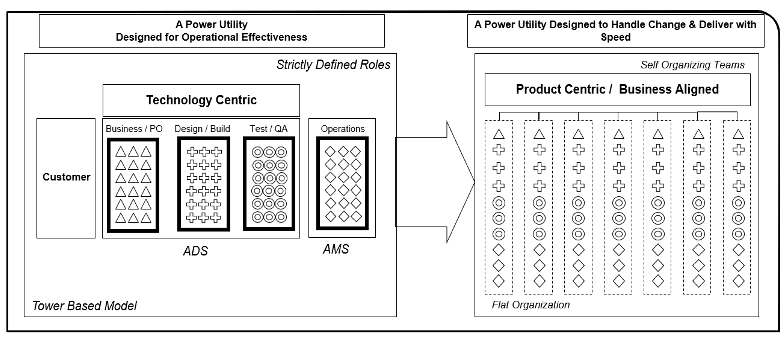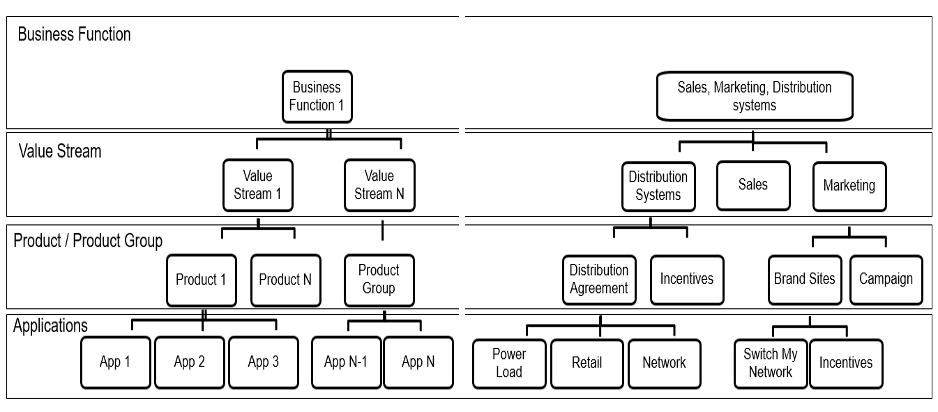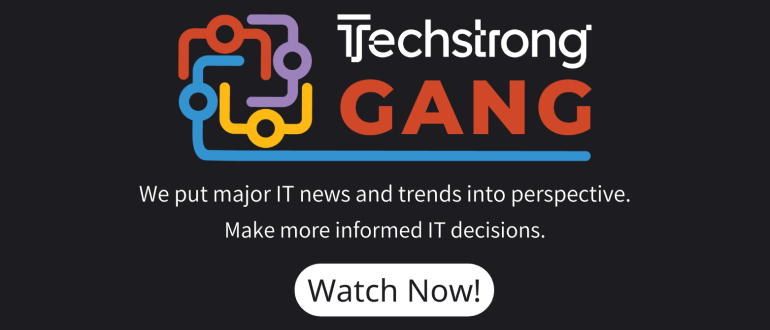Large organizations across the services spectrum are transforming from project-centric operations to product-centric way of working. Customer centricity is driving this transformation, as product-centric organizations put customers at the center of everything they do. Such a transition is largely dependent on how information technology solutions are deployed in the said organization.
This article looks at the importance of a product-centric way of working for utilities organizations, particularly the power sector, which is looking to transform customer interactions by revolutionary use of new digital technologies and solutions such as smart metering and smart homes.
At the onset, power utility organizations should focus on shifting to a product-centric way of working in areas that show promise to deliver innovation and digital enterprise such as customer analytics.

Fig. 1 outlines the current state of play at most power utility companies, where organizational silos and application silos lead to customer challenges in understanding the products and services offered, as well as productivity losses and an increase in reaction times to changes demanded by business and regulation.
In most power utilities, silos exist in business units which are reflected in how the applications supporting those business units are organized and managed. This leads to duplication of effort, work and applications, as well as a waste of time and resources. Customers are often confused about multitudes of service offerings and various channels. There is also an inherent delay in responding to challenges thrown by changes to regulation and/or business environment.
This is changing, though, and one can look at the “meter to cash” processes for a reflection of market realities and customer empowerment.
In our experience, there are four key drivers of a move toward product-centric model:
- Digital Core – to evolve, innovate as well as leverage cloud, DevOps and agility to support the business.
- DevOps practices and agility from ideation to sunset.
- Encourage innovation.
- Digital ready systems.
- Focus on Product value.
- Lean planning and maintenance.
- Intelligent Enterprise – to optimize the cost and delivery of services and encourage innovation.
- Automation to support business agility of the power utility.
- Autonomous operations to support power distribution and customer management.
- Decisions based on insights drawn from customer and market data.
- Focus on the innovation of products, services offered and customer engagement.
- Experience Quality focused on improving customer experience.
- Product centric service delivery.
- Business agility.
- DevOps practices.
- Experience centricity.
- Product and experience-focused metrics.
- Command center that is aligned with the business.
- Service Management and integration for scalability and unification of service delivery in the power utility while retaining a multi-supplier ecosystem as needed.
- Continuous improvements.
- Standardized deployment and integration management.
- Collaboration in a multi-supplier scenario.
- Service lifecycle management.
- Information technology service delivery performance management.
This transformation to a product-centric organization ensures that processes, people, workflows and decisions power the power utility’s ability to:
- Customize services and offers.
- Improved and faster response to customer requests.
- Consistent and distinguished cross-channel experience for customers.
- Boost productivity.
- Eliminate waste.
Shifting to a Product-Centric Model
The product-centric model of delivery uses Agile, DevOps and Lean principles for strategic planning to ensure uncertainties and lack of information do not derail the delivery of services to end customers. A product-centric model places importance on relatively shorter horizons of budget and effort planning over massive planning at the beginning of a financial year. This is important, as a power utility is likely to be able to plan better for a quarter at a time rather than a complete year, particularly in the current economic climate. This not only ties well with the goal of business agility but also ensures improved planning and budgeting, as there is more information available about business goals a quarter at a time. The new teams organized around business capabilities, as shown in Fig. 2, then plan the product backlog, execute, test and deliver business value
to business and customers continually.

Power utilities also need to change and improve their technology-centric solutions to help with forecasting and data analytics. The product-centric organization helps with this goal by identifying gaps for closure and aiding the creation of self-organizing teams that then take on the goals of the organization to address all the identified gaps, including in areas of forecasting and analytics.

Fig. 3 shows a sample organization design for the product-centric model. The figure also shows the breakdown of the structure from business function to value steams to products or product groups and, finally, applications delivering value—all the while ensuring that the goal of customer-centricity is at the center of every decision.
Governance and Metrics
A very important part of creating and adopting a product-centric model of functioning at a power utility includes focusing on the governance of the transformation process, as well as business results accrued from the transformation. The acceleration and adoption of Agile and DevOps practices on the technology side can be tracked through qualitative adoption measures. This leads to product level performance improvement, resulting in better products and faster delivery, with the product delivery mindset focusing on customer-centricity, leading to trends in:
- Faster time to market.
- Improved business satisfaction.
- Improved quality.
- Reduced information technology cost.
Other than this, following metrics and measures be focused upon:
- Adoption Measures.
- Adoption maturity.
- Competency/skill index.
- Operational excellence.
- Product Team Level Measures – measured at team level per sprint.
- Productivity measures such as team velocity and throughput.
- Stakeholder satisfaction measures such as product owner demo satisfaction.
- Quality measures such as percent automated unit test coverage and test effectiveness.
- Business effectiveness measures such as business value delivered per feature and requirement readiness cycle time.
- Product Group Level Measures – measured at product family level per month or quarter.
- Lead time to change.
- Cost of requirement change.
- Release frequency.
- Cost of rework.
- Mean time to recover.
- Application stability.
- Portfolio Level Measures – measured at portfolio level per quarter or half-year.
- Delivery satisfaction index.
- Customer satisfaction index.
- Team Satisfaction Metrics.
- Team happiness index.
- Coaching Effectiveness.
- Coaching feedback.
- Team’s Self Organization Quotient.
- Product ownership.
- Sprint health.
- Team health.
- Technical health.
Potential Areas of Benefit for a Power Utility
There are at least four core areas in which a power utility can expect to experience quantifiable benefits by transforming to a product-centric model of operations. They are:
- Budget and Plan
- Cost and time are the most valued commodities in a tightly run power utility.
- A product-centric model ensures money, effort and time are allocated based on the validation of investment already made in an initiative.
- Improvement in prediction of timelines, effort and benefits of an initiative because of cadence and timeboxing inherent to the product-centric model.
- Managing the Capacity
- The key focus is on alignment with business and continuous delivery of business value.
- The cost of delay and the cost of waiting are also reduced.
- Focus on value delivery with quantified business benefits.
- Governance of Programs
- The governance in product-centric organizations is about the exercise of control on the quantification of benefits.
- The focus in a product-centric organization is on “building the right things the right way.” Rationalization of cost, elimination of waste and focus on business value are direct by-products.
- Managing the Demand
- Continuous visualization and management of demand is an area where benefits are accrued as needs and ideas flow into the strategy filter continually from several sources.
- The product-centric model allows the continuous elaboration of light use cases to ensure value is correctly calculated and assigned to each use case.
- The program, portfolio and product backlogs are continuously evaluated to ensure that there is a cost-benefit sense to each item.
Conclusion
Some of the benefits of a product-centric model usage at power utilities are stated below:
- Customized electricity plans for efficiency, cost or comfortable consumption.
- Improvement in reliability.
- Creation of environmentally sustainable renewable programs of power for the more aware customers.
- Incrementally move toward a “business as usual (BAU)” relationship with regulatory changes.
A product-centric model at power utilities can also help bridge the data divide to improve data and analytics usage and enable creation programs in the following areas:
- Services and products that the customers are most probable to use.
- Optimized collection and prediction mechanisms to create plans to encourage timely payments.
- Create pre-paid services.
- Plans for direct control of load which allowed the utility to reduce air conditioning kind of machinery during peak usage and in return recompense customers.
- Improve pattern recognition for delinquency and fraud management.
- Cross-selling opportunities.
- Targeted sales and marketing campaigns.
This article was co-authored by Anurag Choudhry, Enterprise Architect, Manufacturing & Utilities BG at Tata Consultancy Services.





